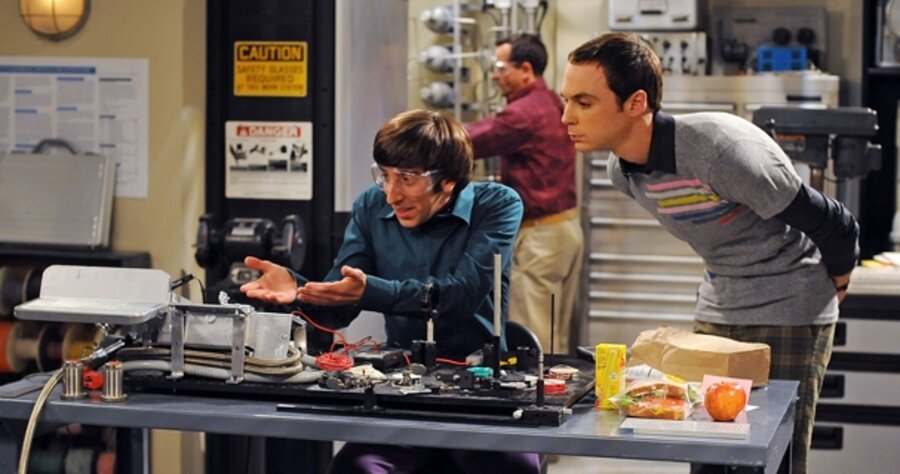Eureka! Real science breaks into TV shows
| Burbank, Calif.
In the space of just 17 months, UCLA astroparticle physicist David Saltzberg has become the nation’s preeminent science teacher. As the consultant to “The Big Bang Theory,” a CBS sitcom about four dweeby scientists and the pretty blonde who lives across the hall, Dr. Saltzberg gets to share his expertise with an audience of millions.
Sample dialogue from a recent taping: Penny asks Leonard, her experimental-physicist neighbor, how he befriended his geeky colleagues, Howard and Raj.
“I don’t know,” Leonard retorts. “How do carbon atoms form a benzene ring? Proximity and valence electrons.”
The 200 members of the live studio audience, perched in bleachers overlooking the set, howl at the punch line – and secretly hope there won’t be a test afterward.
“Maybe there are people Googling things they heard on the show,” says Saltzberg, in a recent phone call from a research center in Antarctica. “As a physicist, the idea of getting 11 million people to tune in to watch physicists every week is a remarkable opportunity. The fact that they show these scientists, these people, as so passionate, has to be helpful.”
Indeed, though scientists may be portrayed as socially inept (“Big Bang Theory”), downright eccentric (“The Eleventh Hour”), or even completely mad (“Fringe”), television’s new wave of lab denizens have become the greatest ambassadors for science since Bill Nye the Science Guy first donned a bow tie. But the respect for these characters comes, in large part, from the real scientists and mathematicians who watchdog the scripts. By steering shows away from the pseudo-scientific jargon of “Doctor Who,” these consultants remind viewers that seemingly arcane principles from Physics 101 have real-world applications.
“Most of the TV writers I meet love science,” says Jennifer Ouellette, director of a National Academy of Science program that connects scientists with entertainment professionals. “They want to have a very believable, plausible, realistic fiction that they create. They care a lot more about that, in part, because audiences have gotten much more sophisticated. You can’t just string a bunch of ‘science-y’ things together because people will know you’re faking.”
In “Numb3rs,” a CBS procedural in which a mathematician helps his FBI-agent brother solve crimes, the mathematical verbiage can stack up faster than a Fibonacci sequence. But the show’s fictitious math whiz demonstrates how science permeates aspects of daily life. Want to know how a computerized answering machine can understand what you’re saying over the phone? Watch the Jan. 30 episode, which features a vault that’s safeguarded by voice recognition, for an explanation of how it all comes down to Fourier transforms and sound wavelets. For extra credit, you can visit “The Math Behind Numb3rs,” an educational website maintained by show consultant Ed Pegg Jr., which is updated after each episode.
“We now are basically in charge of all the mathematics in the show,” says Mr. Pegg, who, as an employee of the math and computational software company Wolfram Research in Champaign, Ill., stays abreast of cutting-edge research. “We will look through some of the mathematical papers we have access to and give them snapshots of pieces that would be really good to add.”
The scientific researchers on the writing staff of “Fringe” go one step further: They imagine what scientists will discover five minutes from now. The show’s Dr. Walter Bishop – part Albert Einstein, part Dr. Frankenstein – assists an FBI task force investigating supernatural cases. Imagine, if you will, an “X-Files” in which the X Factor has a fairly plausible scientific explanation.
“We don’t like to say we’re a science-fiction show,” says Robert Chiappetta, a staff writer for the show who often calls his father, a professor of science education at the University of Houston, for scientific answers. “We like to say we’re a ‘science next’ show.”
Fellow researcher Glen Whitman says they often try to wrap a story around a fascinating piece of science. In one episode, the writers had to create some way to track down a man with an enhanced electromagnetic signature. The two researchers recalled reading about how pigeons use Earth’s magnetic field to navigate. As it turns out, homing pigeons have an enhanced magnetic sense thanks to beaks that are wired to nerves containing magnetic particles. Just as scientists have “reprogrammed” pigeons’ sense of magnetic north in experiments, the show’s scientists similarly manipulate the birds to find their man.
“Fringe” is precisely the kind of show that the characters in “The Big Bang Theory” like to pore over. The sitcom regularly includes vignettes in which the four scientists debate science fiction and science fact. The sitcom’s creators, Chuck Lorre and Bill Prady, have a similar propensity. When they’re not obsessing over “Battlestar Galactica,” they’re keeping up on science literature.
“Both Chuck and I are science geeks,” says Mr. Prady, who works closely with Saltzberg even on the set. “What’s great about David is he’s first and foremost a teacher. Periodically, something will come up and we’ll have a discussion and you’ll get a little class on it.”
Saltzberg, who is in Antarctica building the world’s largest neutrino telescope, loves feedback about his contributions. “I think what’s fun for me is to find when it generates some buzz on the Internet afterward. Especially when people didn’t expect the show to get the science right.”





